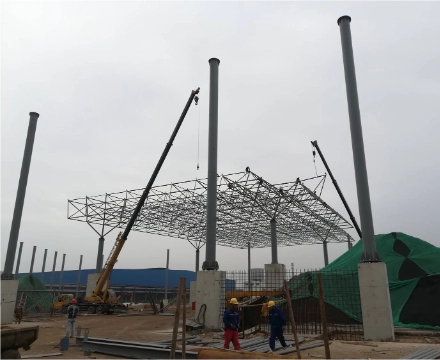Dapeng Town Industrial Park, Tongshan District, Xuzhou City, Jiangsu Province, China
In the multi-crane lifting construction of space frame structures, the arrangement of cranes must consider their working performance and the spatial frame’s airborne displacement requirements. Prior to lifting, the lifting speed of each crane should be measured to control it during lifting. Connecting the hoisting cables of every two cranes with pulleys enables self-adjustment when crane lifting speeds differ.

As previously mentioned by SAFS Steel Structure Engineering Co., if the structure is lightweight or the lifting capacities of four cranes meet requirements, placing the cranes on both sides of the space frame allows for easy mid-air displacement after vertical lifting, meeting the requirements.
Multi-crane lifting typically involves four cranes working together to lift the pre-assembled space frame from the ground, perform mid-air displacement, and then lower and install it. There are two methods: lifting from four sides and lifting from two sides.
For lifting from four sides, to prevent uneven loads due to different lifting speeds, each crane has two hoisting points. The hoisting cables of every two cranes are connected with pulleys, ensuring uniform loading and a stable ascent.
The preparation for multi-crane lifting of space frame structures is simple, and installation is quick and convenient. Lifting from four sides ensures smoother displacement but involves more complex operations. Lifting from two sides is more convenient for mid-air displacement but has slightly less stability. Both methods require multiple cranes and strict operational skills, suitable for lifting medium to small-sized space frame roofs with spans around 40m and heights around 2.5m.